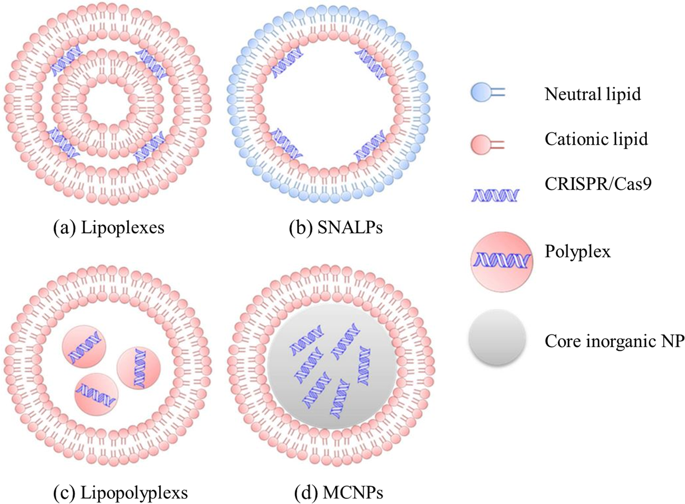Cancer Gene Therapy ( IF 4.8 ) Pub Date : 2019-11-02 , DOI: 10.1038/s41417-019-0141-7 Shuai Zhen 1, 2, 3 , Xu Li 1, 2

|
Liposomes are one of the most widely investigated carriers for CRISPR/Cas9 delivery. The surface properties of liposomal carriers, including the surface charge, PEGylation, and ligand modification can significantly affect the gene silencing efficiency. Three barriers of systemic CRISPR/Cas9 delivery (long blood circulation, efficient tumor penetration, and efficient cellular uptake/endosomal escape) are analyzed on liposomal carriers with different surface charges, PEGylations, and ligand modifications. Cationic formulations dominate CRISPR/Cas9 delivery and neutral formulations also have good performance while anionic formulations are generally not proper for CRISPR/Cas9 delivery. The PEG dilemma (prolonged blood circulation vs. reduced cellular uptake/endosomal escape) and the side effect of repeated PEGylated formulation (accelerated blood clearance) were discussed. Effects of ligand modification on cationic and neutral formulations were analyzed. Finally, we summarized the achievements in liposomal CRISPR/Cas9 delivery, outlined existing problems, and provided some future perspectives. Liposomes are one of the most widely investigated carriers for CRISPR/Cas9 delivery. The surface properties of liposomal carriers, including the surface charge, PEGylation, and ligand modification can significantly affect the gene silencing efficiency. Three barriers of systemic siRNA delivery (long blood circulation, efficient tumor penetration, and efficient cellular uptake/endosomal escape) are analyzed on liposomal carriers with different surface charges, PEGylations, and ligand modifications. Cationic formulations dominate CRISPR/Cas9 delivery and neutral formulations also have good performance while anionic formulations are generally not proper for CRISPR/Cas9 delivery. The PEG dilemma (prolonged blood circulation vs. reduced cellular uptake/endosomal escape) and the side effect of repeated PEGylated formulation (accelerated blood clearance) were discussed. Effects of ligand modification on cationic and neutral formulations were analyzed. Finally, we summarized the achievements in liposomal CRISPR/Cas9 delivery, outlined existing problems, and provided some future perspectives.
中文翻译:

CRISPR / Cas9的脂质体递送。
脂质体是研究最广泛的CRISPR / Cas9传递载体之一。脂质体载体的表面特性,包括表面电荷,聚乙二醇化和配体修饰,可以显着影响基因沉默效率。在具有不同表面电荷,聚乙二醇化和配体修饰的脂质体载体上分析了系统性CRISPR / Cas9传递的三个障碍(长时间的血液循环,有效的肿瘤渗透和有效的细胞摄取/内体逃逸)。阳离子制剂在CRISPR / Cas9递送中占主导地位,中性制剂也具有良好的性能,而阴离子制剂通常不适合CRISPR / Cas9递送。PEG困境(延长血液循环与 减少细胞摄取/内体逃逸)和重复PEG化制剂(加速血液清除)的副作用。分析了配体修饰对阳离子和中性配方的影响。最后,我们总结了脂质体CRISPR / Cas9递送的成就,概述了存在的问题,并提供了一些未来的观点。脂质体是研究最广泛的CRISPR / Cas9传递载体之一。脂质体载体的表面特性,包括表面电荷,聚乙二醇化和配体修饰,可以显着影响基因沉默效率。在具有不同表面电荷,聚乙二醇化,和配体修饰。阳离子制剂在CRISPR / Cas9递送中占主导地位,中性制剂也具有良好的性能,而阴离子制剂通常不适合CRISPR / Cas9递送。讨论了PEG难题(延长血液循环与减少细胞摄取/内体逃逸)和重复PEG化制剂的副作用(加速血液清除)。分析了配体修饰对阳离子和中性配方的影响。最后,我们总结了脂质体CRISPR / Cas9递送的成就,概述了存在的问题,并提供了一些未来的观点。讨论了PEG难题(延长血液循环与减少细胞摄取/内体逃逸)和重复PEG化制剂的副作用(加速血液清除)。分析了配体修饰对阳离子和中性配方的影响。最后,我们总结了脂质体CRISPR / Cas9递送的成就,概述了存在的问题,并提供了一些未来的观点。讨论了PEG难题(延长血液循环与减少细胞摄取/内体逃逸)和重复PEG化制剂的副作用(加速血液清除)。分析了配体修饰对阳离子和中性配方的影响。最后,我们总结了脂质体CRISPR / Cas9递送的成就,概述了存在的问题,并提供了一些未来的观点。









































 京公网安备 11010802027423号
京公网安备 11010802027423号